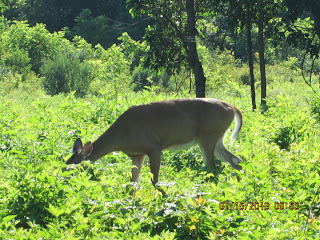(You can read that post and see more early pictures here.)
And while the garden is still a long way from filled in, I am happy with how it's shaping up.This is the same view today. (The old saying about perennials is true: the first year they sleep, the second they creep, the third they leap. These are at the barely creeping stage.) The "Zagreb" coreopsis in the foreground is doing well, as is the creeping sedum along the walkway. The blue fescue was spectacular in early summer but is fading now, and while the switchgrass is blooming, it hasn't yet filled in as much as it will in a year or two. They're not visible in this photo, but this garden is now home to plugs of butterfly weed, wild lupine, and blue aster, and lots of little bluestem and rudbeckia seedlings have been transplanted from other parts of the yard.
Mexican feather grass (Nasella tenuissima) and aromatic aster ( Aster oblongifolius) are doing particularly well. Feather grass has a thuggish reputation in the desert Southwest, but it has behaved itself for three years on our property. In this setting the aster-that-wants-to-colonize-the-world is likely to keep it in check. (If anyone needs starts of this shale barren native aster, I may soon have to start composting clumps of it--we are literally running out of room for this exceedingly enthusiastic plant.) The switchgrass (Panicum virgatum "Prairie Sky") we just planted may help as well.
Never one to resist plant sales, I came home from Lowe's with an agastache "Blue Fortune" and two agastache with tricolor blossoms. These pollinator magnets have definitely improved the view from the front door.
Stay tuned for further developments as the Sorghastrum nutans hedge eventually gets tall enough to be distinguishable from weeds.




































